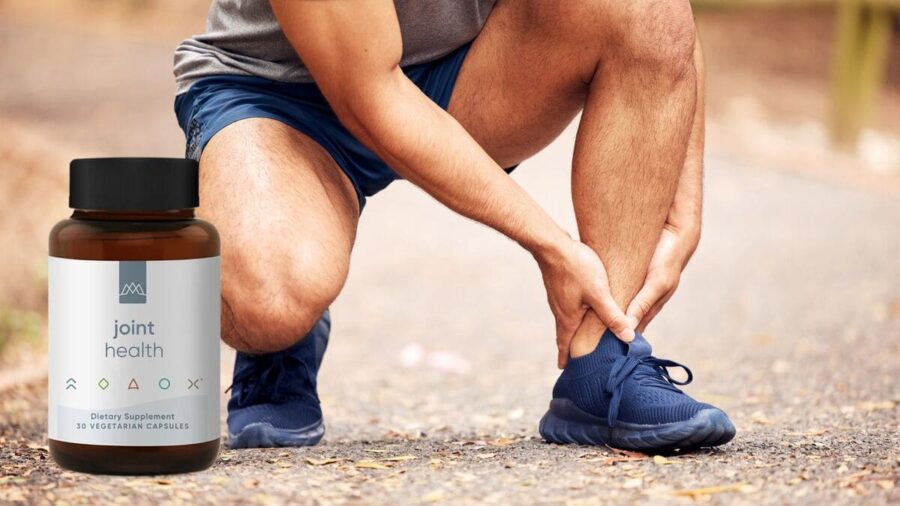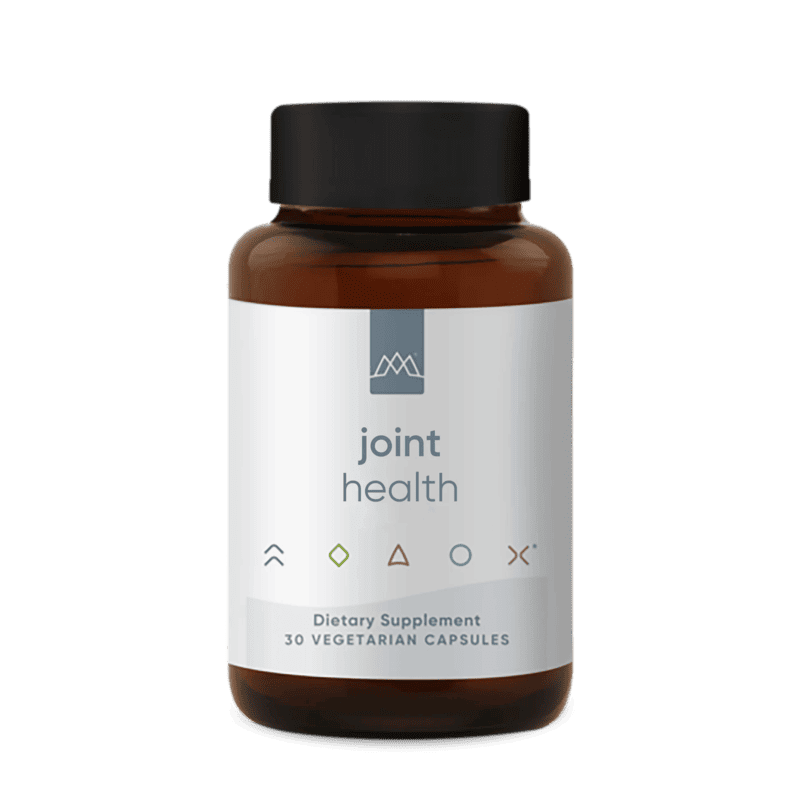Healthy joints allow you to run, walk, exercise, and otherwise move throughout your day.
A joint is where two or more bones join together. Many joints have connective tissue called cartilage where the bones come together. Healthy cartilage allows bones to glide over one another and prevents them from rubbing against each other.[1]
When the tissues in your joints break down over time, a condition called osteoarthritis can occur. Symptoms of osteoarthritis include:
- Pain
- Stiffness
- Swelling
- Changes in how the joint moves
- Feeling like the joint is loose or unstable[2]
Osteoarthritis can impact any joint. However, your hips, knees, spine, and hands are most susceptible. While joint problems including osteoarthritis can impact anyone, women are more likely to experience them. As you grow older, cartilage also deteriorates.[3]
Joint Pain and Exercise
 Any type of joint pain can make moving more difficult. Exercise can help strengthen bones and muscles. You might find, though, that it strains your joints, leading to discomfort. You might even be concerned that more intense exercise such as running can contribute to osteoarthritis.[4]
Any type of joint pain can make moving more difficult. Exercise can help strengthen bones and muscles. You might find, though, that it strains your joints, leading to discomfort. You might even be concerned that more intense exercise such as running can contribute to osteoarthritis.[4]
Running regularly could increase the risk of knee problems and injuries that lead to osteoarthritis. At the same time, running reduces body weight. Being overweight or obese are risk factors for osteoarthritis.[5]
Researchers in one study looked at 74,752 runners and how it might increase the risk of osteoarthritis.
They found that whereas other types of exercise — things like playing soccer or weight lifting — can increase osteoarthritis and the risk of hip replacement, running had the opposite effect: It significantly reduces that risk. Part of that, they suspected, was due to lower-body weight among runners. [5]
Experts also note that runners hit the ground less frequently and more briefly than walking. Running, in other words, has less of an impact on joints than you might imagine. Instead, poor form often contributes to injuries.[6]
Unlike running, cycling is a low-impact activity, making it ideal for people with osteoarthritis. Regular cycling helps your knees move through their full range of motion while strengthening muscles.[7] Cycling can support joint health, but how you do it matters, too.
One study divided men and women between ages 40 and 80 with knee osteoarthritis into a medium-intensity or high-intensity cycling group. The medium intensity here meant they could speak in complete sentences while they cycled. Higher-intensity meant they couldn’t speak in complete sentences.
Participants did four stationary cycling sessions every week for eight weeks. One group cycled for 20 minutes at a moderate intensity. The other group did a seven-minute warm-up that became increasingly more intense, including 45-second high-intensity cycles.
Both groups saw benefits, but the high-intensity group also reported improved physical function, such as how easily they could go from sitting to standing.
Experts recommend some form of exercise for people with osteoarthritis.[8] You can maintain your fitness routine even if you suffer from joint pain. When you run carefully, experts say you can actually reduce the pain associated with osteoarthritis.[9]
The key is to modify that exercise — including its intensity, frequency, and duration — for your specific condition. Consider working with a fitness instructor to optimize form and customize a plan that works for you. Always speak with your healthcare practitioner if you experience joint pain or if you are at risk of osteoarthritis.
Whether or not running or cycling is in your fitness routine, keeping your joints healthy can help you move and perform comfortably at any age. These strategies can help support joint health and reduce your risk of osteoarthritis.
Maintain a Healthy Weight
Every pound of bodyweight you lose can remove four pounds of pressure on your knees. Losing weight can also ease joint pain and reduce inflammation.[10] If you’re overweight or obese, talk with your chiropractor or another healthcare practitioner about an eating plan that works for your condition.
Eat Joint-Supporting Foods
What you put on your fork can support healthy joints and reduce your risk of osteoarthritis. Focus on the whole, nutrient-rich foods in our Core or Advanced Plans to protect your joints and maintain peak physical performance. Among these foods include:
- Chronic inflammation can contribute to joint deterioration.[11] The anti-inflammatory omega-3 fatty acids in wild-caught seafood can help relieve joint pain.[12] Walnuts, chia seeds, flaxseeds, and hemp seeds are all good plant sources of these omega-3 fatty acids.
- Leafy and cruciferous vegetables provide vitamins, minerals, and antioxidants to support healthy joints. Vitamin C in vegetables helps your body make collagen, which helps make cartilage to cushion your joints.[13]
- The spice turmeric provides a compound called curcumin that can help lower inflammation and manage joint pain.[14]
- Ginger can lower inflammation to help relieve pain and improve joint function. In fact, compounds in ginger could work similarly to arthritis medications for relieving pain.[15]
Get Good Sleep
 When you don’t sleep well, you may experience more joint pain and inflammation. Aim for eight hours of quality, uninterrupted sleep every night. Talk with your healthcare practitioner if joint pain prevents you from sleeping. Take our Sleep + Mood Formula if you have trouble falling or staying asleep.
When you don’t sleep well, you may experience more joint pain and inflammation. Aim for eight hours of quality, uninterrupted sleep every night. Talk with your healthcare practitioner if joint pain prevents you from sleeping. Take our Sleep + Mood Formula if you have trouble falling or staying asleep.
Visit Your Chiropractor
Chiropractic care is an ideal way to deal with joint pain. One study found that nine adjustments helped normalize the inflammation levels that resulted in chronic low back pain.[16] These same inflammatory markers can create pain and discomfort in other joints. Your chiropractor can also address other issues that support healthy joints including proper posture while you exercise.
Get the Right Nutrient Support
The right nutrients can provide the support your joints need to thrive and reduce your risk of osteoarthritis.
We’ve brought together the best nutrients for joint health in MaxLiving Joint Health. This unique formula can help reduce inflammation, support healthy connective tissue, and reduce joint discomfort. They include:
- AprèsFLEX®: A highly bioavailable form of Boswellia extract, an herbal extract that can help manage inflammation, support joint flexibility, and maintain healthy cartilage.[17]
- Mobilee®: Contains hyaluronic acid, which can support joint mobility.[18] One study found that it could improve symptoms of knee osteoarthritis.[19] Mobilee® also provides collagen type I and polysaccharides.
- B-2 Cool®: Type II collagen to give joints strength and support.[20]
- Gingerols: Derived from ginger root extract, gingerols help manage inflammation.[21]
We’ve combined these nutrients into one daily capsule. With Max Living Joint Health, you’re providing your body the nutrient support to maintain healthy joints and reduce your risk of osteoarthritis. Healthy joints are critical for any type of exercise, but they also support a full range of motion for all the activities you do in life.
References
[1] https://www.niams.nih.gov/health-topics/kids/healthy-joints
[2] https://www.niams.nih.gov/health-topics/osteoarthritis
[3]https://www.healthline.com/health/osteoarthritis/understanding-aging-and-joints
[4]https://www.webmd.com/arthritis/features/joints-food#2
[5] https://www.ncbi.nlm.nih.gov/pmc/articles/PMC3756679/
[6] https://www.webmd.com/fitness-exercise/features/does-running-damage-your-knees#1
[7] http://www.thepermanentejournal.org/issues/2017/6496-knee-osteoarthritis.html
[9] http://blog.arthritis.org/osteoarthritis/running-knee-oa/
[11] https://www.ncbi.nlm.nih.gov/pmc/articles/PMC3638313/
[12] https://health.clevelandclinic.org/the-best-food-to-help-relieve-your-joint-pain/
[13] https://www.webmd.com/arthritis/features/joints-food#1
[14] https://www.ncbi.nlm.nih.gov/pmc/articles/PMC5003001/
[15] https://www.arthritis-health.com/blog/add-ginger-help-arthritis-pain
[16] https://www.ncbi.nlm.nih.gov/pmc/articles/PMC3188345/
[17] https://www.ncbi.nlm.nih.gov/pmc/articles/PMC3198257/
[18] https://www.ncbi.nlm.nih.gov/pubmed/17091377
[19] https://www.ncbi.nlm.nih.gov/pubmed/23226979/
[20] https://www.webmd.com/osteoarthritis/nutritional-supplements-osteoarthritis#1



